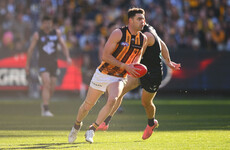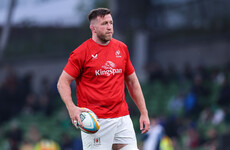THE SECURITY PRESENCE at Temple Hill on that Saturday evening in July 1996 was minimal.
The handful of volunteer stewards were as captivated by the proximity of Premier League footballers as those of us who had paid in at the gate.
Technically they were no longer Premier League footballers, having been relegated a couple of months earlier, but this was still a major event.
Manchester City had travelled to play a game at a venue across the road from where I went to school.
There were some notable names in Alan Ball’s side that won a pre-season friendly 3-1 against Cork City, which was played at the home of the Cork Constitution rugby club.
Ireland internationals Alan Kernaghan and Niall Quinn were among the goals, while the likes of Nigel Clough and Uwe Rosler also featured.
However, one player was largely responsible for the cordon of giddiness that us local kids had formed around the perimeter of the pitch. When he was substituted in the second half, I saw an opportunity to capitalise on the lacklustre stewarding.
Without being noticed, a quick dash brought me as far as the wooden bench that Manchester City’s inactive players were occupying on the sideline. I was now sitting beside a man who I had only seen previously on Match of the Day and in the Merlin Premier League sticker album.
I extended in his direction a pen and the blank page I had wrenched from an old maths copybook. Despite being slightly bemused by the 12-year-old he suddenly had for company, he obliged. My mission was complete. I was the proud owner of Georgi Kinkladze’s autograph.
My recollection of the days and weeks that followed the game isn’t quite as vivid, although I do know that I had a ball at my feet for what seemed like almost every waking hour of what remained of that summer.
Ours was predominantly a hurling household, but my encounter with Georgian royalty sparked an obsession with becoming a professional footballer that didn’t dissipate until this wannabe left-winger was converted into a centre-half a year or so later. As it turned out, I was more Kernaghan than Kinkladze.
The aftermath of the Republic of Ireland women’s national team’s win against Greece in Tallaght last Thursday night evoked fond memories, even if the camera phone has replaced ink and paper nowadays in the clamour for a memento from a meeting with a sporting hero.
After briefly savouring the result in a huddle on the pitch, the Ireland players dispersed and made their way towards the stands to meet the many youngsters who had been beckoning them over since the full-time whistle.
“Where’s Denise O’Sullivan? WHERE’S DENISE O’SULLIVAN?” one of them demanded to know, like a child frantically rummaging for the Wagon Wheels in the carrier bags from the weekly shop.
One can only assume that in the wake of such a hard shift, players crave a long shower, a nice bit of grub and a decent night’s sleep. Yet forgoing those entitlements until every fan leaves Tallaght Stadium satisfied never seems to be a chore for the Irish squad.
There’s a discernible understanding among the group that they’re duty-bound to future generations, and that an hour of their time has the potential to create memories that will last a lifetime for those who idolise them.
Having met Louise Quinn after the win against Ukraine last October, my daughter, who turns four in a few weeks, was keen to do so again – out of concern as much as admiration. She had to see for herself instead of taking my word for it that the Arsenal defender didn’t need a plaster after the clash of heads with a Greek player that momentarily forced her off the pitch.
‘Louise’ – they’re seemingly on first name terms now – was generous with her time again, as were Denise O’Sullivan and Rianna Jarrett. The little one floated out of Tallaght Stadium afterwards, posing questions such as “why does Louise love doing headers so much?” and “Is Denise O’Sullivan from the same Cork as me?”
She’s still of an age where sport isn’t quite as alluring as Paw Patrol, but the fact that she spent much of the weekend heading a balloon around the house is an indication of the impact that sporting role models can have even at this relatively early stage. Previous generations of young girls weren’t quite as fortunate.
“I know personally for myself when I was growing up, there wouldn’t have been too many females that you would have been able to look up to,” Rianna Jarrett said back in October while appearing on The Football Family podcast here on The42. “It’s not because they weren’t good enough, it was just that they weren’t as accessible as female athletes are now.”
The participation figures tell us that there’s more encouragement and support required to help young females to sustain involvement in sport in contrast to their male counterparts. The accessibility of female role models in Ireland is therefore something that shouldn’t be taken for granted.
From the estate in which I live, you could puck a sliotar into St Finbarr’s GAA club, where nine-time All-Ireland senior camogie medal winner Gemma O’Connor is among the many successful graduates.
A couple of kilometres down the South Link road is Cork City FC’s grounds at Bishopstown, which will host the club’s Women’s National League season opener against champions Peamount United on Sunday.
Last August it took no more than 10 minutes to drive to CIT for the Cork City Sports. After procuring a spot at the fence near the start line, we watched from a few feet away as Phil Healy took off in the 100 metres.
References to Ireland’s fastest woman are a regular occurrence for my daughter, starting with the morning drop-off at pre-school: “Let’s see if I can run into the seomra as fast as Phil Healy!”
This has also proven to be a useful tactic when it comes to parenting.
Let’s see if you can eat your dinner as fast as Phil Healy.
Let’s see if you can put your pyjamas on as fast as Phil Healy.
Let’s see if you can get a job and start contributing to the mortgage repayments as fast as Phil Healy.
She might turn around in 10 years and tell me that she’s sick of hearing about the time the teacher wheeled the TV into the room for our class to watch Sonia O’Sullivan winning a silver medal at the 2000 Olympics, and that I can stick sport where the sun doesn’t shine.
Should that time come – and it may well do – all I’ll want is to be able to say that every door was kept open for her along the way.
If you’re a parent of a girl who you’re eager to introduce to sport, the women capable of having a positive influence – women to aspire to and be inspired by – are probably on your doorstep.
There are many hurdles that face women’s sport in Ireland, but a shortage of role models certainly isn’t one of them.
The42 is on Instagram! Tap the button below on your phone to follow us!














Thank Christ I didn’t go to the bookies today
Last night is all of a sudden more bearable now
This year has had some amazing cup results…
Do city even care? Just back from a money spinner in Dubai last night.
And Southampton
City and Chelsea look to be heading out, I doubt either team will be too worried but annoyance for the fans.
Add spurs too.
What a performance by the Boro. Absolutely delighted. Tomlin destroyed Company all game. Well done lads.
Yup defo now. 4 – 2 Bradford, 2 nil M’boro.
The magic of the cup is back…. Just hope it stops for this afternoons game!
Heskey s going to come back to haunt you! Liverpool could easily trip up here. No pun intended….
Trip up today? No shlt, seen some of the results so far? Pool will easily thrash them, or get a nasty fright or defeat….
I am waiting for Mourinho to give his ‘cup games in English are special and unique talk’!!!!! I hope he does one!
He just did Graham on BBC , embarrassing is how he has described it, and he’s right to ….. LVG In !!!!!!
About time…. This reminded me of Zola v Liverpool years ago…. That Cup magic in full effect….
MON and Roy Keane should be trying to get Patrick bamford .the chaps a out and out goalscorer..
The true magic of the cup lads!
Its uniteds to win now with city chelsea and spurs gone but u cant write off another upset
A Bolton win tonight, and Bristol and Brighton tomorrow, get to paddy powers.
Fool
Why is he a fool Luke? You were saved by Gudjohnsen’s poor aim today , suck it up little boy
I guess the reason you Go round calling people “little boy”is because that’s what you are.
I’m really worried about being called a fool by an anonymous idiot who’s afraid to put his name to his opinion. I can call call you what I want because I’m not really saying it to you, just your childish avatar and pseudonym, grow up.